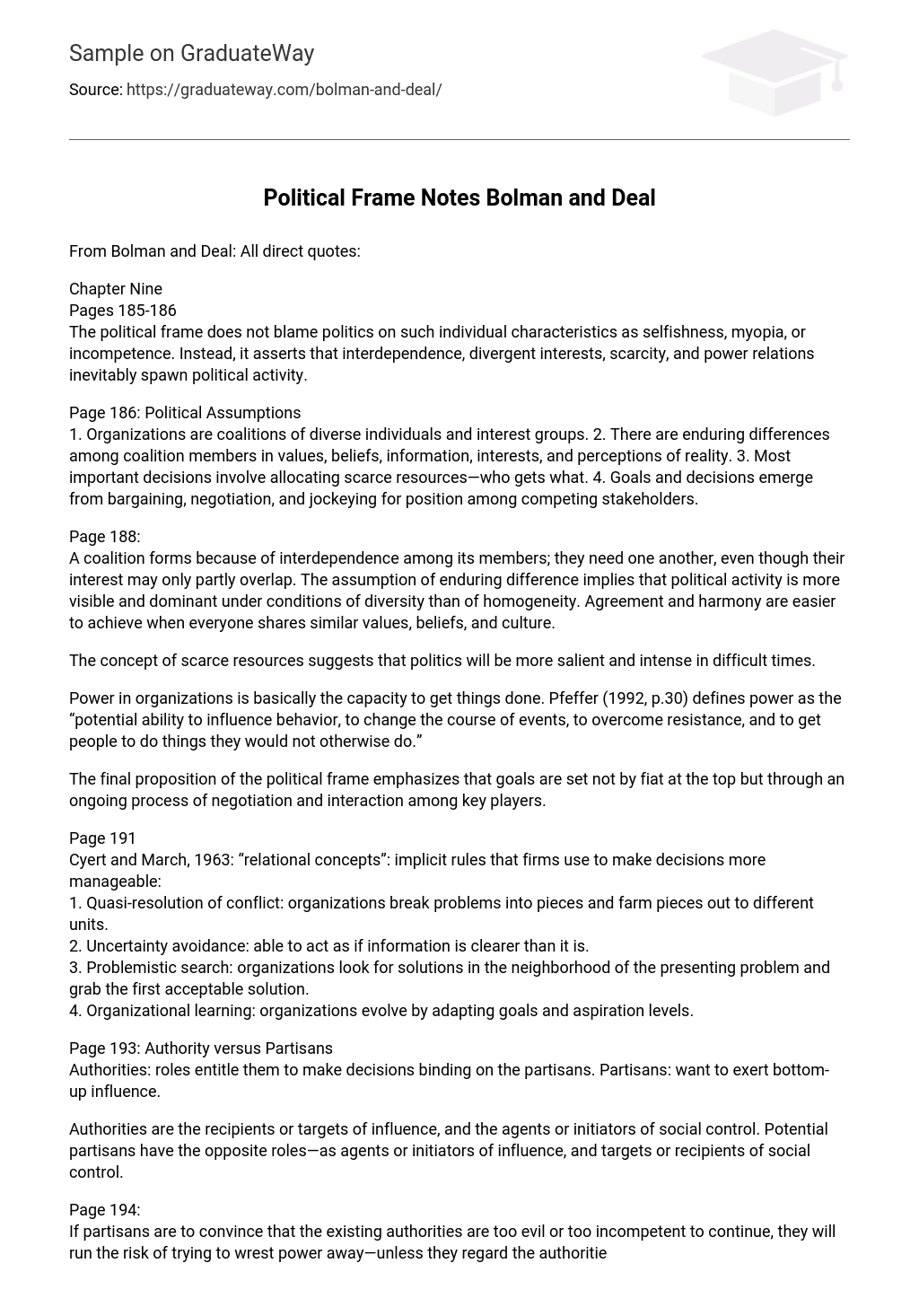The political frame does not blame politics on such individual characteristics as selfishness, myopia, or incompetence. Instead, it asserts that interdependence, divergent interests, scarcity, and power relations inevitably spawn political activity.
Organizations are coalitions of diverse individuals and interest groups. There are enduring differences among coalition members in values, beliefs, information, interests, and perceptions of reality. Most important decisions involve allocating scarce resources—who gets what. Goals and decisions emerge from bargaining, negotiation, and jockeying for position among competing stakeholders.
A coalition forms because of interdependence among its members; they need one another, even though their interest may only partly overlap. The assumption of enduring difference implies that political activity is more visible and dominant under conditions of diversity than of homogeneity. Agreement and harmony are easier to achieve when everyone shares similar values, beliefs, and culture.
The concept of scarce resources suggests that politics will be more salient and intense in difficult times. Power in organizations is basically the capacity to get things done. Pfeffer (1992, p.30) defines power as the “potential ability to influence behavior, to change the course of events, to overcome resistance, and to get people to do things they would not otherwise do.” The final proposition of the political frame emphasizes that goals are set not by fiat at the top but through an ongoing process of negotiation and interaction among key players.
Cyert and March, 1963: “relational concepts”: implicit rules that firms use to make decisions more manageable:
- Quasi-resolution of conflict: organizations break problems into pieces and farm pieces out to different units.
- Uncertainty avoidance: able to act as if information is clearer than it is.
- Problemistic search: organizations look for solutions in the neighborhood of the presenting problem and grab the first acceptable solution.
- Organizational learning: organizations evolve by adapting goals and aspiration levels.
Authorities: roles entitle them to make decisions binding on the partisans. Partisans: want to exert bottom-up influence. Authorities are the recipients or targets of influence, and the agents or initiators of social control. Potential partisans have the opposite roles—as agents or initiators of influence, and targets or recipients of social control.
If partisans are to convince that the existing authorities are too evil or too incompetent to continue, they will run the risk of trying to wrest power away—unless they regard the authorities as too formidable. Conversely, if partisans trust authority, they will leave it alone and even support it in the event of an attack. (Gamson, 1968; Baldridge, 1971)
Poor conflict management leads to the kind of infighting and destructive power struggle….But well-handled conflict can stimulate the creativity and innovation that make an organization a livelier, more adaptive, and more effective place. (Kotter, 1985)
Conflict is particularly likely to occur at boundaries, or interfaces, between groups and units. Horizontal conflict occurs in interfaces between departments or divisions; vertical conflict occurs between levels.
The fist step in effective political leadership is setting an agenda. The effective leader creates an “agenda for change” with two major elements: a vision balancing the long-term interests of key parties and a strategy for achieving the vision, recognizing competing internal and external forces. (Kotter, 1988)
Mapping the political terrain
- Determine channels of informal communication.
- Identify principal agents of political influence.
- Analyze possibilities for both internal and external mobilization.
- Anticipate strategies that others are likely to employ.
A simple way to develop a political map for any situation is to create a two-dimensional diagram mapping players (who is in the game), power (how much clout each player is likely to exercise), and interests (what each player wants). Kotter suggests four basic steps for exercising political influence:
- Identify relevant relationships (figure out who needs to be led).
- Assess who might resist, why, and how strongly (figure out where the leadership challenges will be). Continued on page 210
- Develop, wherever possible, relationships with potential opponents to facilitate communication, education, or negotiation.
- If step three fails, carefully select and implement either more subtle or more forceful methods.
Fisher and Ury
- separate the people from the problem
- focus on interests, not positions
- invent options for mutual gain.
- insist on objective criteria
Bargaining
- Bargaining is a mixed-motive game. Both parties want an agreement but have differing interests and preferences.
- Bargaining is a process of interdependent decisions.
- The more player A can control Player B’s level of uncertainty, the more powerful player A is.
- Bargaining involves judicious use of threats rather than sanctions.
- Making a threat credible is crucial.
- Calculation of the appropriate level of threat is also critical.
Block’s four steps of “let go of them” strategy for dealing with adversaries:
- tell them your vision
- state your best understanding of their position
- identify your contribution to the problem
- tell them what you plan to do without making demands.





